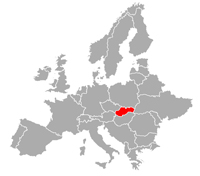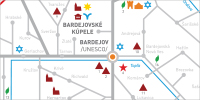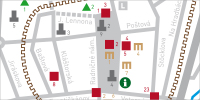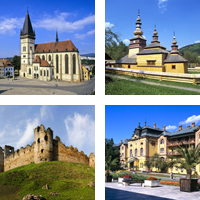                 |
The former town hall, built in gothic-renaissance style, is a unique architectural gem not only in the Šariš region but also in the entire Slovakia. The town hall served as a seat of the urban council, the center of local trade and as a kernel of social-cultural life. A remarkable synthesis of renaissance and late gothic architecture, the building is an architectural and ideological offset to the Church of Saint Egidius.
The town hall is situated in the middle of the town square. Slovak historians considered it to be the first secular renaissance building in the territory. The town hall’s exterior is adorned by several sculptures. The most famous being that of Knight Roland – the defender of city’s rights. On the other side of the spectrum lies an infamous sculpture of a boy, bent over and displaying his naked buttocks towards the reeve’s house. The cheeky piece is an ingenious form of revenge against the city’s officials who denied the artisans their rightful pay.
The end of the century saw a marked improvement in economic and social life of Bardejov’s burghers and increased prestige of the city. This phenomenon naturally led to more urban development and buildings for the purposes of trade and city council’s representation were set up. The city’s officials decided to build a lavish town hall in the city center which contained the local market. The city’s council however held its meetings in the reeve’s office, away from the main city center.
In 1505 a new construction work, under the supervision of magister Alexander, began. During the same year Alexander oversaw the work on the ground floor of the city hall. Several other magisters took part in the project. One of the most prominent was Alexius – the man who built the bay window in 1508, in addition to other windows and portals. In 1509 magister John of Prešov built the first floor and gables which were further adorned by sculptures, thus making the city hall complete from architectural perspective.
|
The paintings from 1510 – 1511 are a work of local magister Theofil Stanczel. The artist decorated the city’s coat of arms and painted image of the Last Judgment in the council room. The following years saw the artisans of Bardejov busy working on the interior of the building decorating the rooms and arranging furniture. In 1556 the artisans finished the roof over the bay windows. The exterior was painted in 1641 by magister Matthew Grünwald.
Subsequent centuries brought only conservation work. Local authorities refurbished the building as a Museum of the Šariš County (today’s Šariš Museum) after a fire incident in 1902.
Since its inception the town hall emphasized the importance of Bardejov in the upper Šariš region. In addition to being the seat of the town council, the building also served as a socio-cultural center. While the ground floor served for commerce, the premises of the first floor functioned as town’s treasury.
The southwestern corner of the town hall features two hollow weighing scales dated to 1510 and 1620 respectively. These instruments were used for measuring corn and legume. The weighing scales are adorned by the town’s coat of arms and a date of origin around its circumference. The coat of arms and the initials of the Reeve guaranteed the just accuracy of the weighing scales.
Adorned by a richly decorated bay window, the eastern facade is the most valuable architectural part of the town hall. The town’s aldermen used the bay window (an arquière) as an entry point. The coat of arms and initials of the town council members are also displayed on the window. The arquière terminates in a decorated ledge adorned by reliefs and a painted shield depicting a calendar with the year 1641.
The southern shield of the town hall is adorned by a clock, the town’s and the kingdom’s coat of arms. Other decorations include the sculptures of a lion, a bearded man, a monkey and linen vendor.
|
On the northern shield, one can find further sculptures depicting a demon, a dragon, a king, a man holding an hourglass, a stonemason as well as a man holding a stick. The perimeter of the town hall is composed of sculptures depicting individual artisan’s trades.
The figure of Knight Roland, the defender of town’s privileges, stands on the peak of the southern shield, armed with a halberd. The original stone sculpture, made by magister John of Prešov in 1509, was replaced by a wooden piece in 1641. The latter was covered in an outer layer of copper. The sculpture of 1641 is kept in the interior of the town hall, while outside, the original post is filled with a replacement copy.
The interior decoration serves as a reminded of the building’s importance. Every room is decorated, whether by portals, canopies, adorned doors or interior painting. The largest hall in the building was reserved for councils of the town officials. The hall is decorated with a richly adorned ceiling of 1508, period furniture and equipment. Another unique feature of the building is its authentic wooden roof framework, untouched by ages.
At present, the town hall serves as a place for the historical exhibition “The Free Royal Town of Bardejov”. The most important artefacts of the exhibition include gothic sculptures, period guilds items, urban seal of 1453, precious Venetian glasses, a brilliant ring of Empress Elisabeth as well as The Little Calvary – an opus of magister Paul of Levoča.
The artistic value of Bardejov’s town hall is of European wide importance and illustrates period progressive thinking. The building, together with several other monuments, was enlisted into UNESCO during 2000.
Translated by:
Mgr. Samuel Beňa, M.A.
|



















